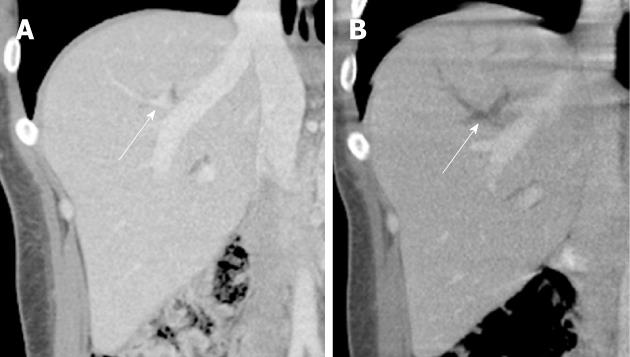Copyright
©2012 Baishideng Publishing Group Co.
World J Radiol. May 28, 2012; 4(5): 224-227
Published online May 28, 2012. doi: 10.4329/wjr.v4.i5.224
Published online May 28, 2012. doi: 10.4329/wjr.v4.i5.224
Figure 1 Fluoroscopic spot image from the second percutaneous transhepatic cholangiography procedure performed in the right lobe.
A: On this fluoroscopic spot image from the second percutaneous transhepatic cholangiography procedure performed through the right biliary system, the small 3Fr inner cannula (white arrow) is seen traversing the right hepatic lobe. Contrast opacification demonstrates filling of the right intrahepatic ducts and common bile duct, all normal in caliber. There is also brisk flow through the ampulla into the duodenum (white arrowheads); B: Delayed fluoroscopic image demonstrates complete emptying of the biliary system with contrast flowing forward into the duodenum and jejunum, without evidence of a biliary stricture. The 3Fr inner cannula was then removed and tract embolization was performed without incident.
Figure 2 Contrast-enhanced computed tomography images before the percutaneous transhepatic cholangiography demonstrate a patent Segment VIII portal vein branch that developed localized portal vein thrombosis after the procedure.
A: A coronal reformatted image from a contrast-enhanced computed tomography (CT) image demonstrates that the portal vein branches (white arrow) to Segment VIII are patent; B: A coronal reformatted images from the contrast-enhanced CT scan performed when the patient presented to the emergency room 48 h after the percutaneous transhepatic cholangiography (PTC) procedure demonstrates thrombosis of a segmental and several subsegmental portal vein branches (white arrow) in Segment VIII, in the same location where the PTC was performed.
- Citation: Brennan IM, Ahmed M. Portal vein thrombosis following percutaneous transhepatic cholangiography-An unusual presentation of Prothrombin (Factor II) gene mutation. World J Radiol 2012; 4(5): 224-227
- URL: https://www.wjgnet.com/1949-8470/full/v4/i5/224.htm
- DOI: https://dx.doi.org/10.4329/wjr.v4.i5.224










